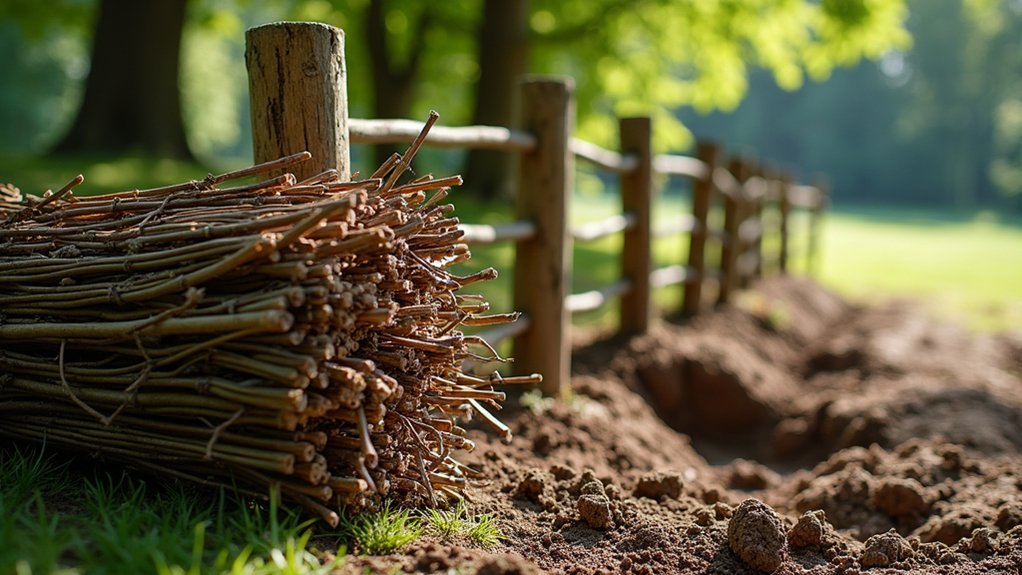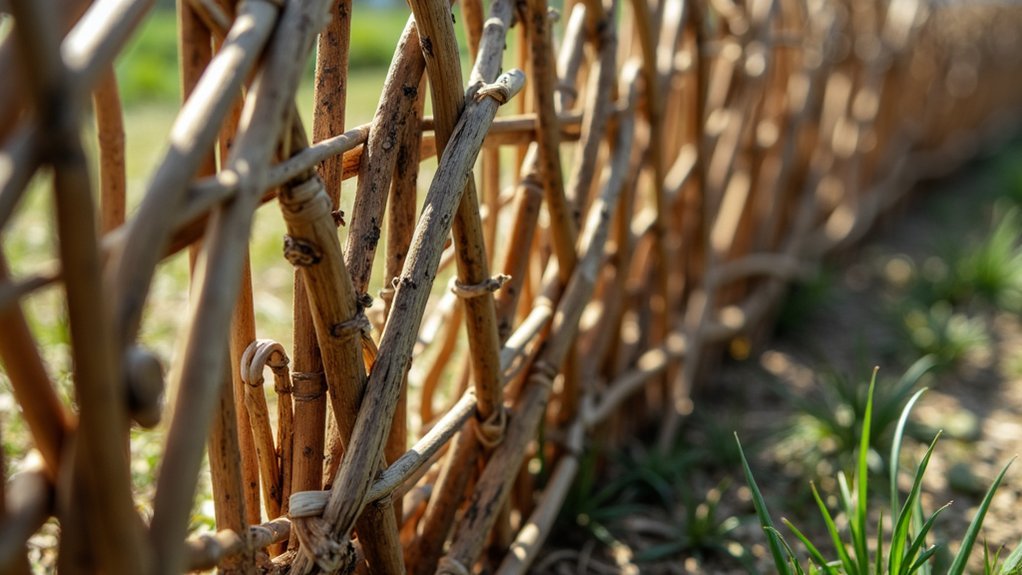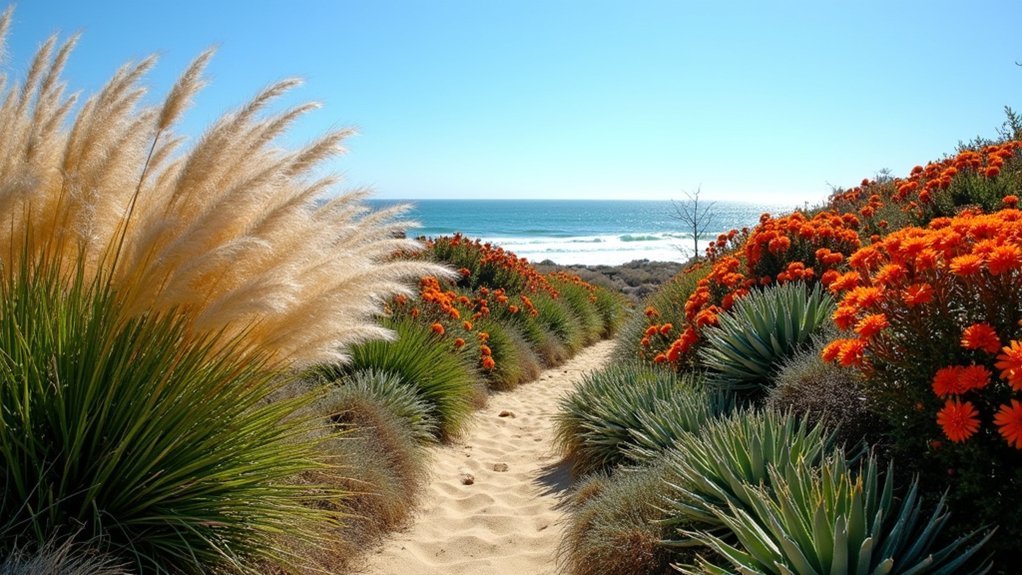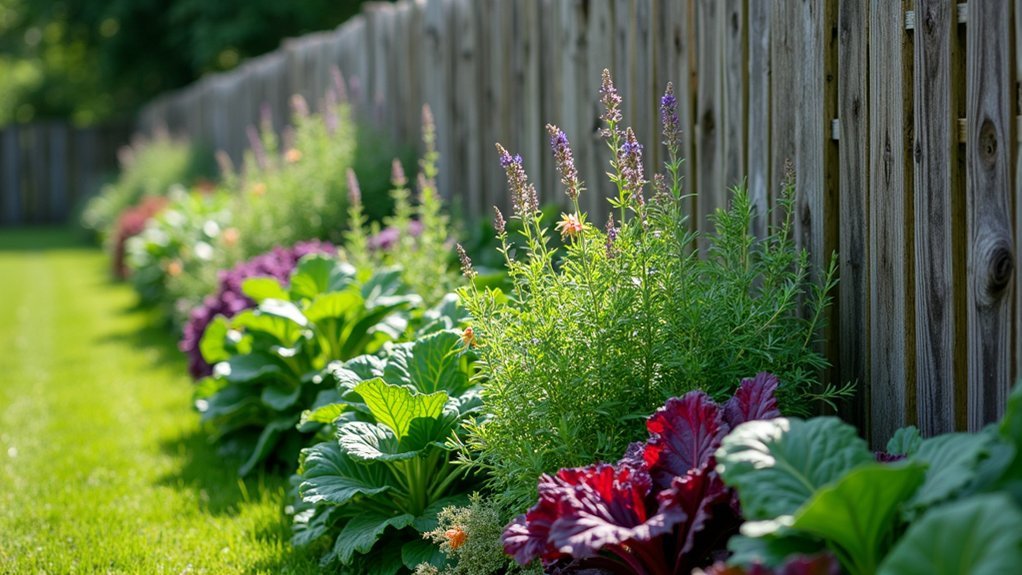To build a willow hurdle fence, start by hammering sweet chestnut posts into the ground about 1.8m apart, at least 300mm deep. Gather freshly cut willow branches and soak dried ones to restore flexibility. Weave these branches horizontally, alternating in front of and behind the uprights. Firmly tap down each rod to maintain tension and secure edges by folding ends back into the structure. Trim any protruding ends for a clean finish. The following steps will transform your garden with this natural, timeless boundary.
How to Build a Willow Hurdle Fence

To build a sturdy willow hurdle fence, you’ll need to start with the foundation. Begin by hammering thick willow posts into the ground as uprights, ensuring they’re evenly spaced and firmly anchored. This provides the structural integrity your fence needs.
Next, gather young, flexible willow stems for weaving. Alternate these natural materials in front of and behind the uprights, creating a strong interlaced pattern. Start with a solid bottom row of switches, then continue working upward, tapping each rod down firmly as you go.
For a professional finish, secure the ends by tucking or twisting them around the uprights.
Don’t forget to maintain your willow hurdle by regularly trimming protruding ends and checking for wear. With proper care, your fence will last 5-10 years.
Materials and Tools for Willow Hurdle Construction
Three essential materials form the backbone of any willow hurdle project: freshly cut willow switches for flexibility, sturdy sweet chestnut posts (50-75mm diameter), and appropriate fasteners if needed.
Freshly cut willow, robust sweet chestnut posts, and quality fasteners—the holy trinity of successful hurdle crafting.
You’ll need thick willow varieties for the uprights, while thinner, more pliable stems work best for weaving.
Your tools arsenal should include a sledgehammer for setting posts firmly into the ground at 1.8m intervals.
Don’t forget secateurs and loppers for trimming willow ends precisely. Always wear gloves to protect your hands during the weaving process.
If you’re working with dried willow hurdles, soaking them beforehand restores flexibility and prevents breakage.
Consider using a mold while building to maintain the desired shape and enhance structural stability throughout the construction process.
Preparing and Setting Up the Fence Posts

Setting posts properly forms the foundation of a sturdy willow hurdle fence.
Select sweet chestnut posts 50–75mm in diameter and plan to space them about 1.8m apart. Drive each post at least 300mm into the ground using a sledge hammer, guaranteeing they’ll withstand weather and provide a solid base for weaving it back and forth.
Consider creating gentle curves in your fence line—this adds both strength and aesthetic appeal while creating an effective visual barrier.
Cut the tops of all posts at the same height for a tidy finish that enhances the hurdle’s appearance.
After installation, allow your posts to settle for a day or two before beginning the weaving process. This patience guarantees they’re firmly anchored and ready to support your willow weaving.
Selecting and Preparing Willow Branches
The perfect willow branches make all the difference in creating a durable, attractive hurdle fence. Brown willow (Salix viminalis) is your best choice for weaving, offering superior flexibility and strength. For visual interest, consider adding Flanders red willow varieties to your design.
When selecting and preparing your materials:
- Choose freshly cut branches between 1-2 cm in diameter for ideal handling and strength.
- Soak any dried willow for several hours to restore flexibility before weaving.
- Trim all branch ends to remove sharp points that might interfere with the weaving process.
- Sort your branches by size and color to create a systematic approach to construction.
Proper preparation guarantees your willow branches will bend without breaking, making the weaving process smoother and resulting in a sturdier finished fence.
Weaving Techniques for Sturdy Hurdles

To master the basic weave, you’ll need to alternate each willow rod in front of and behind the upright posts while tapping down firmly after each addition.
You can strengthen the edges of your hurdle by folding and weaving the ends of the willow rods back into the structure, creating both stability and a clean finish.
This careful attention to edge work prevents unraveling and maintains the fence’s structural integrity throughout its lifetime.
Mastering the Basic Weave
Three essential elements form the foundation of any successful willow hurdle fence: fresh materials, proper technique, and attention to detail.
When weaving your willow hurdle, select flexible stems that’ll bend without breaking around the upright posts.
To create a basic weave that’ll last for years:
- Start with sturdy uprights spaced evenly, typically 8-10 inches apart and about six feet in length.
- Begin weaving your first willow rod in front of the first upright, behind the second, and continue this alternating pattern.
- Add subsequent rods in the opposite weaving pattern to the previous one.
- After completing each row, firmly pound down the rods to maintain tension and eliminate gaps.
This interlocking pattern creates tremendous strength, allowing your fence to withstand weather and time.
Strengthening the Edges
Building a robust willow hurdle fence requires special attention to its most vulnerable points—the edges. When starting your weave, secure the first rod tightly by alternating its position (in front and behind) around the uprights. This creates a solid foundation for your hurdle.
Select thicker willow switches for the outer sections, as they’ll provide superior stability against pressure. After completing each row, pound down the rods to guarantee they lie flat against one another.
For maximum durability, wrap the thick end of each rod back around the final upright, effectively locking it in place. This reinforcement at critical junctions prevents unraveling.
Finish by adding 2-3 layers of double twisted willow rods along the edges. This technique not only strengthens your hurdle but also creates a polished, professional appearance to your completed fence.
Securing and Finishing Your Willow Fence
Once you’ve completed the main weaving process, properly securing and finishing your willow hurdle fence transforms it from a functional structure into a polished garden feature.
The finishing touches on your willow hurdle aren’t merely decorative—they’re what elevate your creation from practical to professional.
To guarantee structural integrity and a tidy appearance:
- Secure the final willow rods by twisting them firmly around the last upright post, then lock the weave by pulling up the bottom ends and tucking them into the structure.
- Use secateurs and loppers to trim all protruding willow rod ends flush with each upright post for a neat finish.
- Saw the tops of your sweet chestnut uprights just above the completed weave height for a uniform look.
- Regularly check your fence for any loose ends and re-twist them as needed to maintain the structure’s strength and extend its lifespan.
Frequently Asked Questions
How Long Will Willow Fencing Last?
Your willow fencing will last 5-10 years with proper maintenance. You’ll get maximum durability by using freshly cut green willow, regularly trimming loose ends, and placing it in a sheltered location away from harsh weather.
Which Lasts Longer, Willow or Hazel Hurdles?
Hazel hurdles will outlast willow hurdles. You’ll get 5-10 years from willow under good conditions, but hazel’s thicker, sturdier rods offer greater durability against weather and wear, especially in demanding outdoor environments.
How Long Does It Take to Grow a Willow Fence?
Growing a willow fence takes about 3-4 years from planting to maturity. You’ll need to establish your cuttings for 1-2 years first, but you’ll see significant growth each season as they develop.
Can You Bend Willow Hurdles?
Yes, you can bend willow hurdles. When working with freshly cut green willow stems, they’re flexible enough for creating curves and shapes. Just work gradually to avoid snapping, and use alternating weaving patterns for stability.
In Summary
Now that you’ve completed your willow hurdle fence, you’ll enjoy its natural beauty and practical function for years to come. With proper maintenance, your handcrafted fence will age gracefully, developing a silvery patina over time. Don’t forget to check for loose weaves occasionally and trim any new growth. You’ve mastered an ancient craft that brings sustainable, biodegradable charm to your garden space.





Leave a Reply